What's New Under The Sun
Madison Historic Dial Returns
Monday, 13 October 2025 22:49
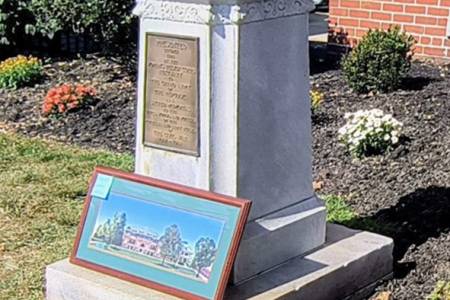 On October 4, 2025 Madison Historical Society of Ohio was able to have their sundial returned after 32 years, when in 1993 it was moved to the lawn of Lake County Courthouse to reduce the chance of vandalism. The sundial was originally placed at Madison Home 100 years ago on Saturday, October 24, 1925 during a conference of the Women's Relief Society. From 1904 to 1962 the state ran this...
On October 4, 2025 Madison Historical Society of Ohio was able to have their sundial returned after 32 years, when in 1993 it was moved to the lawn of Lake County Courthouse to reduce the chance of vandalism. The sundial was originally placed at Madison Home 100 years ago on Saturday, October 24, 1925 during a conference of the Women's Relief Society. From 1904 to 1962 the state ran this...
Elements of Dialing Course - 2025
Monday, 15 September 2025 19:42
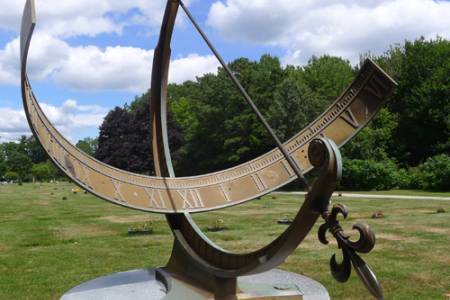 NASS is pleased to announce the upcoming fifth instance of Elements of Dialing, our introductory course about sundials, their history, and the science that makes them work. The free 12-lesson course, intended for those are new to sundialing, runs from 27 October 2025 until 26 April 2026. The course instructor is Robert Kellogg, NASS Vice President and Sundial Registrar. Bob will be...
NASS is pleased to announce the upcoming fifth instance of Elements of Dialing, our introductory course about sundials, their history, and the science that makes them work. The free 12-lesson course, intended for those are new to sundialing, runs from 27 October 2025 until 26 April 2026. The course instructor is Robert Kellogg, NASS Vice President and Sundial Registrar. Bob will be...
Sun Queen of World War II
Thursday, 11 September 2025 23:11
 A Hungarian born American scientist, Mária Telkes (1900-1995), was called "The Sun Queen" and among other honors, was postmousthly inducted into the National Inventors Hall of Fame. She lived to 95 and for most of her life developed solar power in a variety of forms.
Trained as a biophysicist, she worked for Westinghouse Electrical and Manufacturing Company in Pittsburgh, PA, where she...
A Hungarian born American scientist, Mária Telkes (1900-1995), was called "The Sun Queen" and among other honors, was postmousthly inducted into the National Inventors Hall of Fame. She lived to 95 and for most of her life developed solar power in a variety of forms.
Trained as a biophysicist, she worked for Westinghouse Electrical and Manufacturing Company in Pittsburgh, PA, where she...
2025 Conference -Ottawa
Thursday, 28 August 2025 23:25
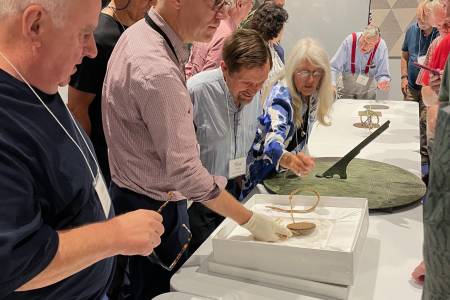 The annual NASS Conference was held 7-10 August, 2025 in Ottawa. As usual, the conference began late Thursday afternoon with an introduction social and a "grab bag give away", taking your chances with tickets to win the bag's prize. Will Grant was the final winner of the Walton Double Planar Polar Sundial, but Paul Ulbrich beat the statistic odds and won this prize three times,...
The annual NASS Conference was held 7-10 August, 2025 in Ottawa. As usual, the conference began late Thursday afternoon with an introduction social and a "grab bag give away", taking your chances with tickets to win the bag's prize. Will Grant was the final winner of the Walton Double Planar Polar Sundial, but Paul Ulbrich beat the statistic odds and won this prize three times,...
Prosciutto di Portici Sundial's Owner
Tuesday, 10 June 2025 18:51
 Prosciutto di Portici (Ham) Sundial
Photo: Getty Images
The Prosciutto di Portici Sundial, more often called the Portici Ham Sundial, dates from the first century somewhere between 8 BCE to 79 CE. This small silvered bronze dial was uncovered on 11 June, 1755 in the ruins of Herculaneum (current day Portici) in the "Villa of the Papyri", buried in...
Prosciutto di Portici (Ham) Sundial
Photo: Getty Images
The Prosciutto di Portici Sundial, more often called the Portici Ham Sundial, dates from the first century somewhere between 8 BCE to 79 CE. This small silvered bronze dial was uncovered on 11 June, 1755 in the ruins of Herculaneum (current day Portici) in the "Villa of the Papyri", buried in...
Hamilton Dial Dedicated
Friday, 06 June 2025 21:01
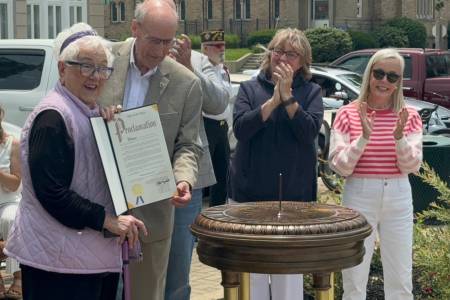 Sundial dedication May 31, 2025. At left is Kathleen Stuckey Fox, with the City Proclamation presented by Mayor Pat Moeller and City Council on-lookers Carla Fiehrer and Susan Vaughn offering congratulations.
On May 31, 2025 at 1pm, the Hamilton, Ohio, sundial (NASS Sundial Registry #1109) was re-dedicated in Monument Park. Originally dedicated in 1941 to the...
Sundial dedication May 31, 2025. At left is Kathleen Stuckey Fox, with the City Proclamation presented by Mayor Pat Moeller and City Council on-lookers Carla Fiehrer and Susan Vaughn offering congratulations.
On May 31, 2025 at 1pm, the Hamilton, Ohio, sundial (NASS Sundial Registry #1109) was re-dedicated in Monument Park. Originally dedicated in 1941 to the...
Frans Maes Received a Royal Decoration
Monday, 24 March 2025 21:33
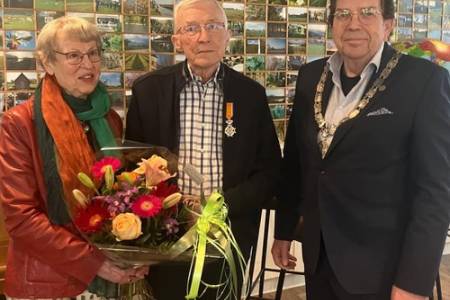 Several years ago Frans decided to write the course on sundials that included self assessment questions to force students not only to read the text, but to internalize the concepts. And a final submittal question "not necessarily a difficult question, but: no answer, no new lesson." Thus Frans Maes began writing lessons and sending them out to students.
NASS has now used his material to create...
Several years ago Frans decided to write the course on sundials that included self assessment questions to force students not only to read the text, but to internalize the concepts. And a final submittal question "not necessarily a difficult question, but: no answer, no new lesson." Thus Frans Maes began writing lessons and sending them out to students.
NASS has now used his material to create...
Pros and Cons of Daylight Savings Time
Monday, 24 March 2025 15:37
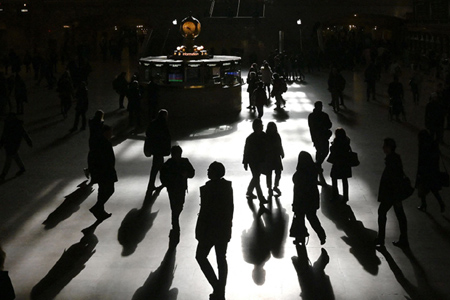 In a 24 March 2025 article from the on-line Science Advisor (American Association for the Advancement of Science) Phie Jacobs summarizes the "great debate" of the yearly shift from standard time to daylight savings time. In January 2025 the US Senate introduced the Sunshine Protection Act to permanently have daylight savings time year round. Certainly 54% of Americans do not like the...
In a 24 March 2025 article from the on-line Science Advisor (American Association for the Advancement of Science) Phie Jacobs summarizes the "great debate" of the yearly shift from standard time to daylight savings time. In January 2025 the US Senate introduced the Sunshine Protection Act to permanently have daylight savings time year round. Certainly 54% of Americans do not like the...
Native American Moon Alignment Ring
Friday, 21 March 2025 19:26
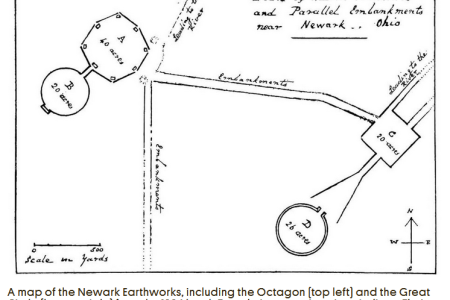 Perhaps the most famous alignment circle in the United States is the Cahokia Woodhenge near St. Louis constructed between 700-1400 CE by Cahokia Indigenous native Americans. But there were an estimated 10,000 other earthen mounds that once were scatter across the mid-west..
In an article from Atlas Obscura (https://www.atlasobscura.com/articles/octagon-earthworks-ohio) by Olivia Young on March...
Perhaps the most famous alignment circle in the United States is the Cahokia Woodhenge near St. Louis constructed between 700-1400 CE by Cahokia Indigenous native Americans. But there were an estimated 10,000 other earthen mounds that once were scatter across the mid-west..
In an article from Atlas Obscura (https://www.atlasobscura.com/articles/octagon-earthworks-ohio) by Olivia Young on March...
Hamilton Dial under Restoration
Friday, 21 March 2025 18:37
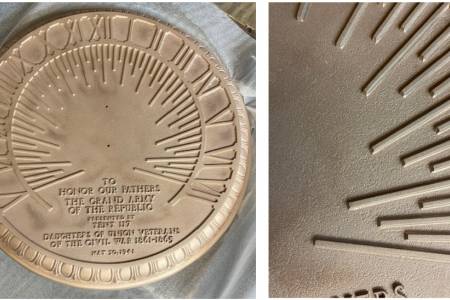 The Hamilton dial is in the restorative care of Jarrett and Celene Hawkins (Hawkins & Hawkins Custom, LLC in Cincinnati Ohio https://www.studio-hawkins.com/) in preparation for the dial's dedication on Saturday, May 31, 2025.
The face of the Hamilton Grand Army of the Republic (GAR) sundial has been cleaned and bead-blasted showing the dial as it was cast 84 years ago. In the process,...
The Hamilton dial is in the restorative care of Jarrett and Celene Hawkins (Hawkins & Hawkins Custom, LLC in Cincinnati Ohio https://www.studio-hawkins.com/) in preparation for the dial's dedication on Saturday, May 31, 2025.
The face of the Hamilton Grand Army of the Republic (GAR) sundial has been cleaned and bead-blasted showing the dial as it was cast 84 years ago. In the process,...
VSSC Space Museum gets Polar Sundial
Tuesday, 17 December 2024 23:47
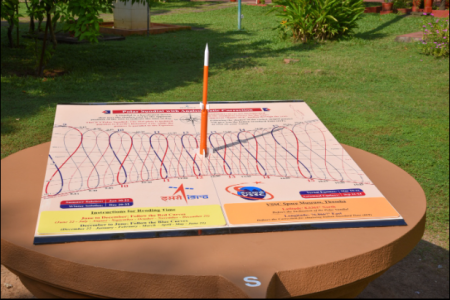 In November 2024, a team consisting of members from SPL, TTDG and CMD of VSSC successfully designed and installed an accurate and fully functional sundial at the Rocket Garden of VSSC Space Museum, Thumba (8.53°N, 76.86°E). Following a space theme, the vertical gnomon is a 3-stage rocket that casts its daily and seasonal shadow on a dial face 1 1/2 meters by 1 meter. The the sundial face...
In November 2024, a team consisting of members from SPL, TTDG and CMD of VSSC successfully designed and installed an accurate and fully functional sundial at the Rocket Garden of VSSC Space Museum, Thumba (8.53°N, 76.86°E). Following a space theme, the vertical gnomon is a 3-stage rocket that casts its daily and seasonal shadow on a dial face 1 1/2 meters by 1 meter. The the sundial face...
Historic Sundials of Andalusia
Saturday, 16 November 2024 00:07
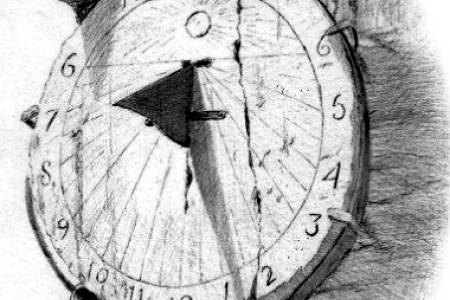 Esteban Martínez Almirón has published a new book Historical Sundials: Forgotten Andalusian Treasures (Relojes de Sol Históricos Tesoros Andaluces Olvidados) In it he reviews over 400 sundials from the Andalucian region of southern Spain Originally to celebrate the 25th year of the website https://relojandalusi.org/
Esteban Martínez Almirón began showing his sundial drawings on the site....
Esteban Martínez Almirón has published a new book Historical Sundials: Forgotten Andalusian Treasures (Relojes de Sol Históricos Tesoros Andaluces Olvidados) In it he reviews over 400 sundials from the Andalucian region of southern Spain Originally to celebrate the 25th year of the website https://relojandalusi.org/
Esteban Martínez Almirón began showing his sundial drawings on the site....
Italian Gnomonist Giacomo Agnelli Dies
- Details
- Hits: 17129
Dear Friends,
A great loss has hit our gnomonic community in Italy. Our friend Giacomo Agnelli died about a week ago. Giacomo was one of the great gnomonists of the past. He had written dozens of articles in engineering and horology, also dealing with mechatronics [mechanical] sundials. He had worked at the European space project, and had frequent ...articles for our magazines [on] gnomonics. He had participated in all meetings of horology in Italy and was known for his satirical cartoons and gnomonic caricatures ...
Marjorie Kelly Webster, Collector of Sundials and Scientific Instrument Passes at 95
- Details
- Hits: 18741
Along with her husband, Mrs. Webster spent much of her life and fortune combing auction catalogs and antiquarian shops to create a collection of early scientific instruments so renowned, it is considered in the same company as the Museum of the History of Science at Oxford University and the National Maritime Museum in Greenwich, England, according to Bolt, Adler planetarium vice president for collections. The Websters are primarily responsible for the world-class collection of scientific instruments at the Adler.
NASS is supporting the Adler to catalog their sundial collection enhanced over the years by Marjorie Kelly and her husband.
Biography of Gino Schiavone
- Details
- Hits: 18211
 Gino Schiavone: After studying Liberal Arts at Loyola University and Fine Arts at Chouinard Art Institute in Los Angeles I began a career of what I called “making wonderful things.” Some thirty years ago I happened upon some books about sundials at a library. This happy accident changed my life. These books introduced me to the wide range of sundials and methods for their design. I was enthralled and inspired; I was in love. I decided to make fine sundials and embarked on a new course of study.
Gino Schiavone: After studying Liberal Arts at Loyola University and Fine Arts at Chouinard Art Institute in Los Angeles I began a career of what I called “making wonderful things.” Some thirty years ago I happened upon some books about sundials at a library. This happy accident changed my life. These books introduced me to the wide range of sundials and methods for their design. I was enthralled and inspired; I was in love. I decided to make fine sundials and embarked on a new course of study.
2025 Conference -Ottawa
- Details
- Hits: 1807
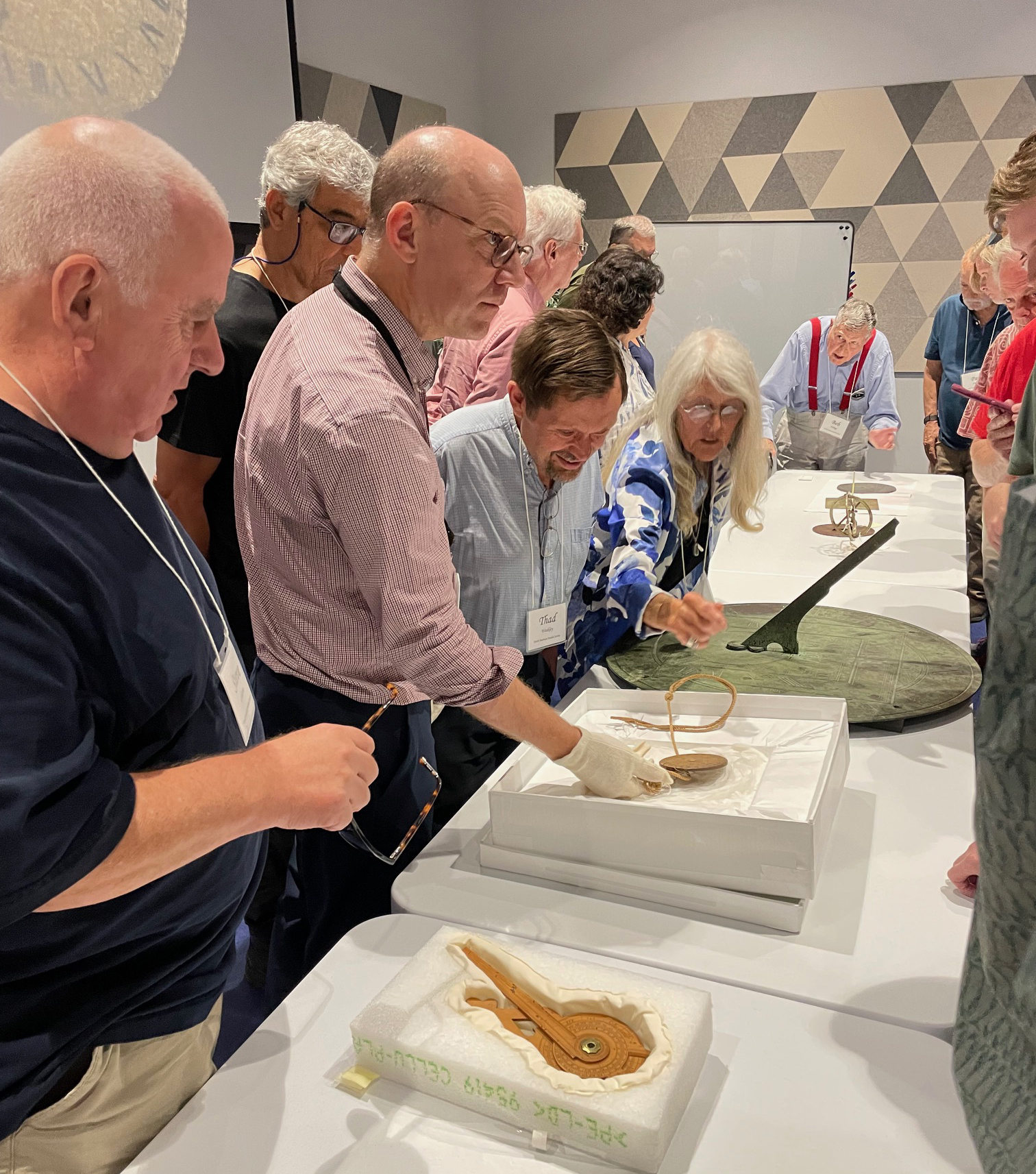 The annual NASS Conference was held 7-10 August, 2025 in Ottawa. As usual, the conference began late Thursday afternoon with an introduction social and a "grab bag give away", taking your chances with tickets to win the bag's prize. Will Grant was the final winner of the Walton Double Planar Polar Sundial, but Paul Ulbrich beat the statistic odds and won this prize three times, ultimately conceding the dial to Will.
The annual NASS Conference was held 7-10 August, 2025 in Ottawa. As usual, the conference began late Thursday afternoon with an introduction social and a "grab bag give away", taking your chances with tickets to win the bag's prize. Will Grant was the final winner of the Walton Double Planar Polar Sundial, but Paul Ulbrich beat the statistic odds and won this prize three times, ultimately conceding the dial to Will.
Friday was a bus tour of Ottawa dials, including the corner dials at the Mother House of the Sisters of Charity (NASS #127) and the hemispherium dial originally located in Rideau Falls Park, but now located in Rockcliffe Park Pavillion (NASS #449). The highlight of the tour was a visit to the Canada Science and Technology Museum. We were greeted by David Pantalony, Curator of Science and Medicine, who introduced us to the archival collection of sundials and solar compasses. This was followed by historical remarks from Jean-François Lozier, Curator, French North America of the Canadian Museum of History. After examining dials (look but don't touch) we paused for lunch in the Archive room. The day ended at our Ottawa hosts home where Mike Moghadam showed his sundial and his wife Esther and family provided refreshments.
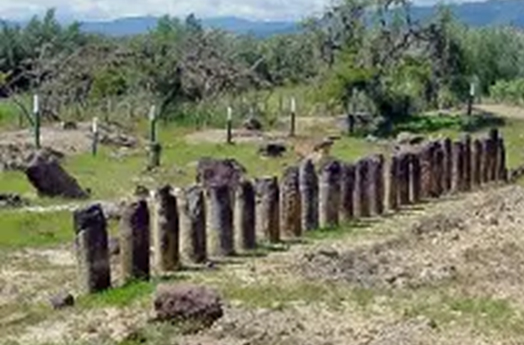 Saturday and Sunday consisted of a wide variety of dialing presentations. Frank King presented a double header on "Eine Block Sonnenuhr" and the mystery of the seven dials woodcut. Others discussed sundial projects (Paul Ulbrich, Mark Montgomery), odd sundials (Fred Sawyer), vector mathematics for sundials (Roger Goyder, Zoon Nguyen and Evan Boxer Cook), the sunlight itself and how it affects bio-rhythms (Pam Morris), navigating in the Arctic (Tom Kreyche), trips to exotic sundials (Geoff Parsons) and Will Grant's trip to Columbia and the Muisica Indian megaliths. All this and more. Read the attached Retrospective for details.
Saturday and Sunday consisted of a wide variety of dialing presentations. Frank King presented a double header on "Eine Block Sonnenuhr" and the mystery of the seven dials woodcut. Others discussed sundial projects (Paul Ulbrich, Mark Montgomery), odd sundials (Fred Sawyer), vector mathematics for sundials (Roger Goyder, Zoon Nguyen and Evan Boxer Cook), the sunlight itself and how it affects bio-rhythms (Pam Morris), navigating in the Arctic (Tom Kreyche), trips to exotic sundials (Geoff Parsons) and Will Grant's trip to Columbia and the Muisica Indian megaliths. All this and more. Read the attached Retrospective for details.
Group photo at Dominion Observatory in front of Bldg 9, the dome for the Astrograph seen at the museum.
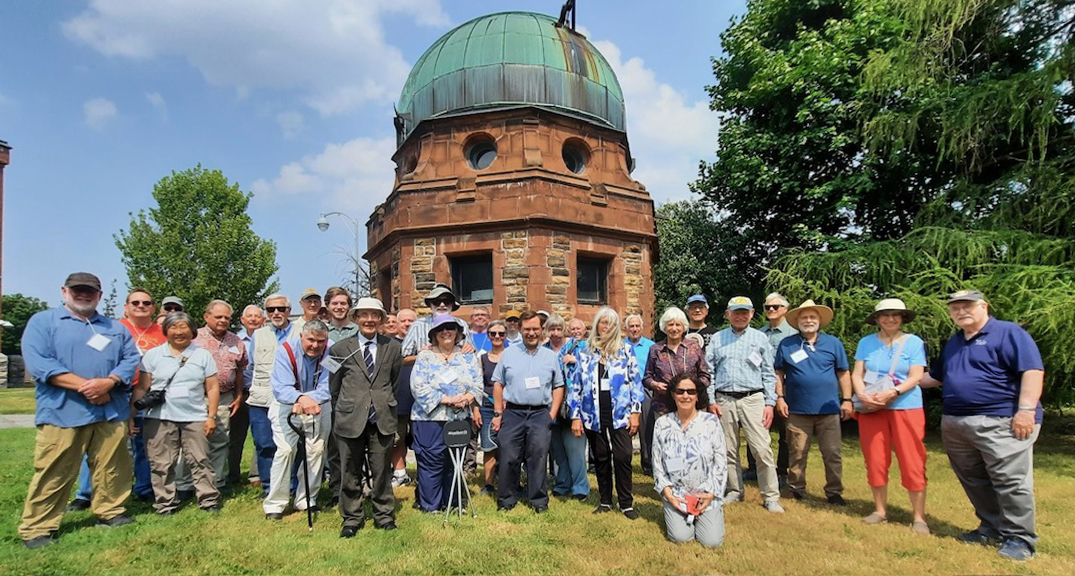
12 (Back Row Left to Right) Steve Johnson, Bob & Bo Manning (barely visible), Bill Thibault, Geoff Parson, Jack Aubert, Mark Montgomery, Marvin Taylor (barely visible), Evan Boxer-Cook, Mike Moghadam, Steve Lelievre, Jeff Brewer, Maddy Lelievre, Russell Goyder, Christine Northeast, Jim Stegenga, Will Grant, José Montes, Tom Kreyche. (Front Row Left to Right) Dave & Joyce Robinson, Bob Kellogg, Frank King, Bryan & Kathy Preas, Thad Weakley, Pam Morris, Chris & Roger Bailey, Paul Ulbrich, Phil & Fred Sawyer. (Center-Front) Martha Villegas. Not in the photo were Marc Boon & Susan Hayes, Lizzy Longsworth, Phyllis Montgomery and Kate Aubert.
2021 Conference - Philadelphia
- Details
- Hits: 7302
The North American Sundial Society, after by-passing the 2020 Conference due to Covid restrictions, held the 26th annual meeting from August 5th - 8th at the Hilton Garden Inn, Center City, Philadelphia. The venue was similar to past conferences: Thursday night social and door prizes for attendees, Friday a bus tour of 11 sundials in the Philadelphia area, Saturday sundial presentations and annual dinner, finishing on Sunday with more sundial presentations and the annual general meeting (AGM).The dial tour took us walking through Philadelphia parks and arboratums and visits to University of Pennsylvania, Swarthmore College, and Haverford College.
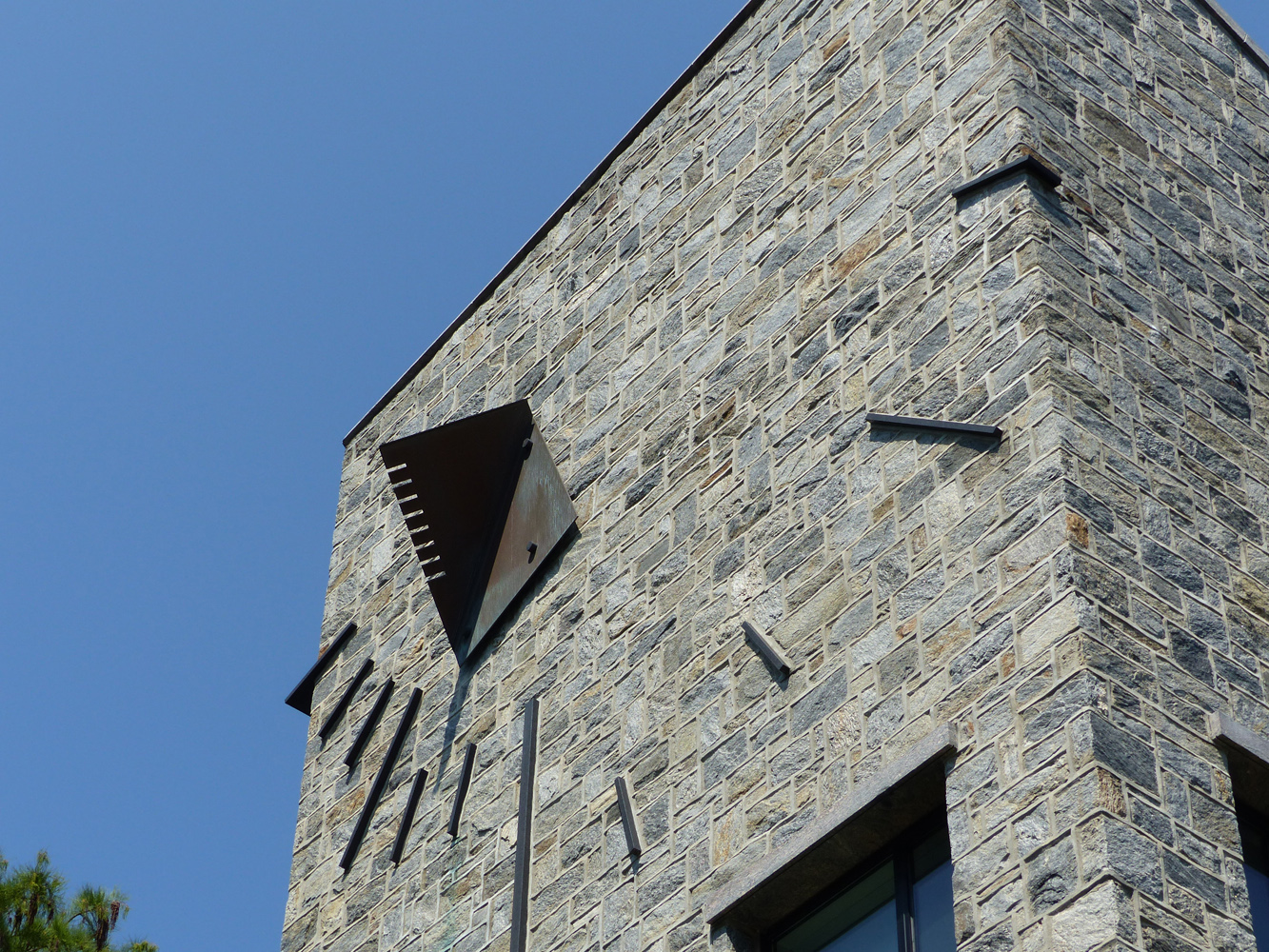 At Swarthmore we saw the modern vertical declining dial on Kohlberg Hall, designed by Martin Cowan. Frederick Orthlieb, professor and chair of the Dept of Engineering at Swarthmore "had a part in locating the bent-plate gnomon so as to give correct indications on the vertical wall. As installed, the gnomon's indicating edge (which lies on a Polar Axis) casts quite a short shadow in Autumn and Winter and requires some observing skill to make a close estimate of indicated time, but in Spring and Summer the longer shadow moves over the granite hour marks very plainly."
At Swarthmore we saw the modern vertical declining dial on Kohlberg Hall, designed by Martin Cowan. Frederick Orthlieb, professor and chair of the Dept of Engineering at Swarthmore "had a part in locating the bent-plate gnomon so as to give correct indications on the vertical wall. As installed, the gnomon's indicating edge (which lies on a Polar Axis) casts quite a short shadow in Autumn and Winter and requires some observing skill to make a close estimate of indicated time, but in Spring and Summer the longer shadow moves over the granite hour marks very plainly."
For the annual group photo attendees gathered around the "Point Where Things Change", a N-S meridian dial commissioned in 2001 by the Redevelopment Authority of the City of Philadelphia and designed by Michael Grothusen. The dial is on the grounds of Tasepoint Corporate Headquarters.
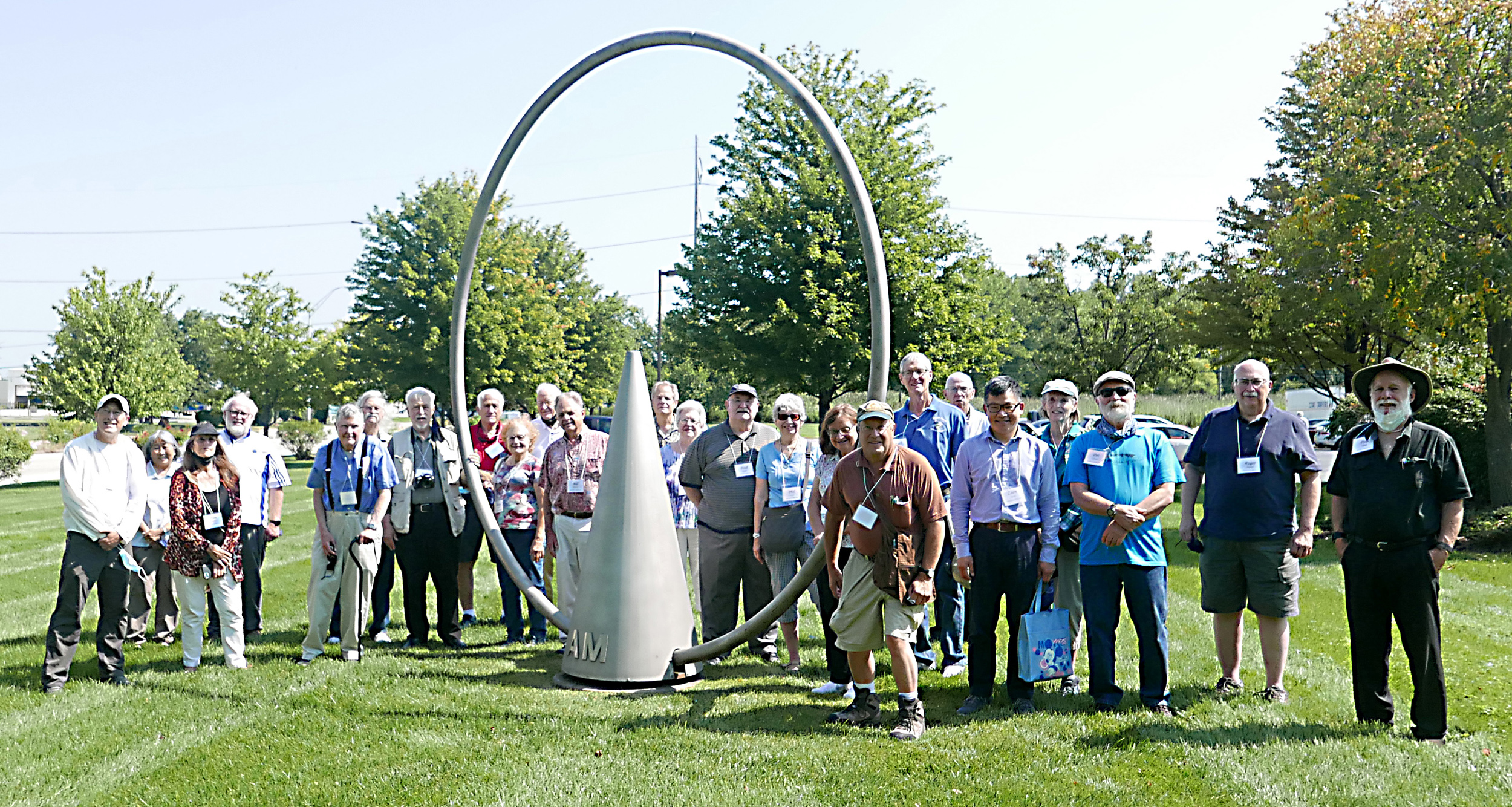
From Left to Right: Bill Gottesman, Joyce Robinson, Pam Morris, David Robinson, Bob Kellogg, George Wilson, Jack Aubert, Will Grant, Betsy Wilson, Jim Holland, Bill Thibault, Art Paque, Tish Grant, Fred Sawyer, Philomena Sawyer, Phyllis Montgomery, Jeff Kretsch , Mark Montgomery, Marvin Taylor, Zoon Nguyen, Kate Aubert, Pat O'Hearn, Roger Dignard, Paul Ulbrich.
3D Printing Tutorials
- Details
- Hits: 13260
 Look for the new menu tab:3D Printing Tips. Starting this December (2019) NASS begins a series of tutorials using OpenSCAD and other software for designing and printing 3D objects. As you might guess, we'll focus on creating sundials and other shadow casting objects. Download your copy of OpenSCAD at http://www.openscad.org and join our tutorials. If you want even more detail on 3D sundials, join NASS and receive The Compendium with Bill Gottesman, Steve Lelievre, Bob Kellogg and others writing in the regular column "3D Design and Printing Sundials."
Look for the new menu tab:3D Printing Tips. Starting this December (2019) NASS begins a series of tutorials using OpenSCAD and other software for designing and printing 3D objects. As you might guess, we'll focus on creating sundials and other shadow casting objects. Download your copy of OpenSCAD at http://www.openscad.org and join our tutorials. If you want even more detail on 3D sundials, join NASS and receive The Compendium with Bill Gottesman, Steve Lelievre, Bob Kellogg and others writing in the regular column "3D Design and Printing Sundials."
Seattle Sundial Tribute
- Details
- Hits: 25373
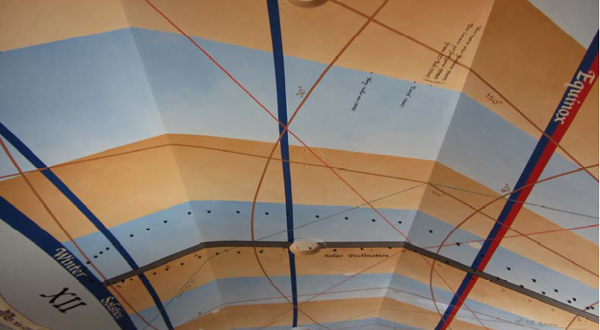
Professor Woody Sullivan's Reflection Dial
[photo - NASS Conference 2011]
|
Professor Woody Sullivan of the University of Washington in Seattle, whose long time motto has been "Seattle, sundial capital of North America", received a tribute from local television station King5 for sundials that he has designed or brought to light around Seattle. His pride and joy is his ceiling reflection dial [photo at left] As related by Joan Kinsey from King5 news, "It took Sullivan and an artist three years to chart hundreds of reflected dots across the top of Sullivan's remodeled garage..." The celestial view includes hour lines, solar declination lines of the equinox and the soltices, and a variety of transit dots that represent special dates and times to the Sullivan family.
Sullivan, a professional astronomer, has helped design a number of Seattle dials. As Joan Kinsey notes, "His first one [a declining vertical dial] went up in 1994 on the side of the astronomy building at the university ...The huge wall sundial ignited Sullivan's passion to make more and research the ones that already exist in town." Woody has created a Sundial Trail of prominent Seattle dials ranging from several vertical dials increasing the educational value at local schools to a large Shepard's dial and an occulus gnomonic dial.
Of course being Seattle, Woody scribed an appropriate sundial motto, "I thrive in the sun, Can't work in the rain. So, if I'm beclouded, please come back again. "
Read about it at: king5 news
Native American Moon Alignment Ring
- Details
- Hits: 3813
Perhaps the most famous alignment circle in the United States is the Cahokia Woodhenge near St. Louis constructed between 700-1400 CE by Cahokia Indigenous native Americans. But there were an estimated 10,000 other earthen mounds that once were scatter across the mid-west..
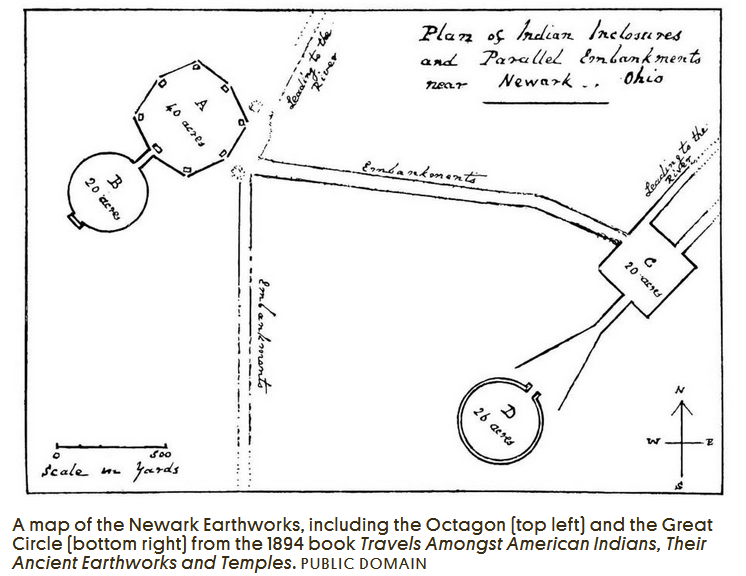 In an article from Atlas Obscura (https://www.atlasobscura.com/articles/octagon-earthworks-ohio) by Olivia Young on March 5, 2025:
In an article from Atlas Obscura (https://www.atlasobscura.com/articles/octagon-earthworks-ohio) by Olivia Young on March 5, 2025:
"Just outside of Ohio’s capital, a wall of earth rises five feet from the smooth ground in a perfect circle,1,000 feet (305m) wide. Standing inside that ring of mounded terra firma today, you can see the Moon rise right where the walls break and an ancient passageway leads to an enormous octagonal arena. Thousands of years ago, the Native Americans who built it would have been standing in that very spot, watching the same celestial scene." This is the position of the lunar standstill, the farthest north that the moon rises in the sky and occurs every lunar cycle of 18.6 years.
"The significance and sophistication of the Octagon Earthworks has been compared to that of Stonehenge and the pyramids in Giza. Despite that, the 2,000-year-old site was leased to a country club and used as a golf course for more than 100 years—up until January 1, 2025. After more than a decade of negotiating the Ohio History Connection (OHC) took over the lease and opened the sacred landmark to the public."
Dr. John Low, director of the Newark Earthworks Center at Ohio State Univ. noted that, "At the start of the 1800s, there were more than 40 tribes in what is now Ohio, including the Shawnee, Kickapoo, and Miami. By 1842, they had all been forcibly removed under the Indian Removal Act." But the indigenous people's vibrant culture and astronomical precision remains in their earthen mounds. Since 2023 this and other indigenous earthworks have been designated by UNESCO as a World Heritage Site (the Hopewell Ceremonial Earthworks), including the Octagon and Alignment Ring.
Ancient Egyptian Clock
- Details
- Hits: 5055
 Dario Radley reports in Archaelogical News Online Magazine (Aug 24, 2024) that an ancient observatory from the 6th century BCE was found by the Egyptian Supreme Council of Antiquities at Tell El-Fara'in archaeological site.
Dario Radley reports in Archaelogical News Online Magazine (Aug 24, 2024) that an ancient observatory from the 6th century BCE was found by the Egyptian Supreme Council of Antiquities at Tell El-Fara'in archaeological site.
“It highlights the advanced astronomical knowledge of the ancient Egyptians, including their ability to determine the solar calendar and significant religious and agricultural dates,” Dr. Mohamed Ismail Khaled, Secretary-General of the Supreme Council of Antiquities, told Ahram Online.
Archaeological News Online further reported: One of the key findings at the site is an inclined stone sundial, known as a shadow clock, which was used to measure time based on the sun’s position. This sundial consists of a straight row of limestone slabs, approximately 4.80 meters long, with several vertical and horizontal blocks that may have been used to measure the angle and shadow of the sun throughout the day. Dr. Ayman Ashmawy, head of the Egyptian Antiquities Sector at the Supreme Council of Antiquities, described this sundial as one of the most significant artifacts found, illustrating the Egyptians’ skill in timekeeping and their understanding of solar movements.
Read the full article at:https://archaeologymag.com/2024/08/astronomical-observatory-discovered-in-kafr-el-sheikh/
